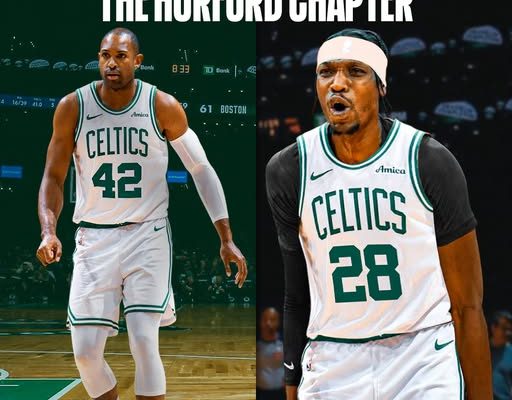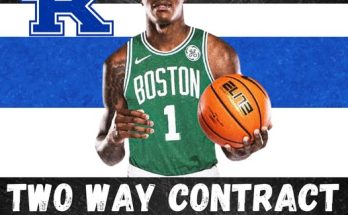The Boston Celtics are entering the 2025–26 NBA season with a frontcourt landscape that looks drastically different from what fans expected just a few months ago. Over the offseason, the team’s intentions were clear: retain key veterans Luke Kornet and Al Horford, both of whom were seen as stabilizing forces in Boston’s frontcourt rotation. Kornet’s size, mobility, and ability to stretch the floor had made him a reliable piece, while Horford, despite being past his prime, was still a figure of leadership and defensive acumen that the Celtics valued highly. Yet as August rolled in, both players were set to depart the team. Kornet has already agreed to join the San Antonio Spurs, and Horford is expected to sign with the Golden State Warriors once they complete the Jonathan Kuminga contract situation. This left Boston in a position where a quick but effective solution was needed to ensure the frontcourt would not only remain competitive but could also maintain the team’s aspirations of deep playoff contention.
Enter Chris Boucher, the former Toronto Raptors forward who has agreed to a one-year deal with the Celtics. Boucher’s arrival marks a significant pivot in Boston’s strategy. Unlike Horford, who excelled as a defensive anchor with a cerebral understanding of team defense, Boucher brings a combination of athleticism, energy, and floor-spacing ability that could redefine the role of the Celtics’ bench. He is not a like-for-like replacement for Horford’s veteran savvy or Kornet’s floor-spacing consistency, but he offers versatility and immediate impact in ways that could suit a team looking to retool on the fly rather than rebuild. Boston’s decision to bring Boucher aboard signals that the organization is not content to tread water; instead, it is looking to maximize its roster flexibility while maintaining a competitive posture in the Eastern Conference.
Boucher’s strengths are well-suited to the Celtics’ current roster composition. He is a forward who can stretch the floor with his three-point shooting, which is increasingly crucial in today’s NBA where spacing dictates the effectiveness of both offense and defense. His ability to hit shots from the perimeter will complement Boston’s existing core of shooters and ball handlers, ensuring that driving lanes remain open and pick-and-roll actions are more effective. Moreover, Boucher’s rebounding presence is a key addition. In a frontcourt that has lost the size and defensive grounding of Horford and Kornet, securing boards on both ends of the court becomes essential. Boucher’s timing and athleticism allow him to contribute immediately in this area, giving Boston more options in rotation and reducing reliance on their starters to dominate rebounding duties.
Perhaps most importantly, Boucher injects energy into the Celtics’ lineup. He is a player who thrives in transition, provides shot-blocking when defenders overcommit, and brings a level of hustle that can change the tone of a game. In many ways, he represents the type of player who can swing momentum in crucial playoff games. For a Celtics team intent on remaining competitive in the Eastern Conference, this spark off the bench could be a decisive factor, especially when facing opponents with more experienced or deeper rosters.
While Boucher may not carry the same leadership aura as Horford, his presence could allow Boston to cultivate new on-court chemistry and fresh energy in rotations. The team’s coaching staff, led by Brad Stevens, is known for its ability to maximize player strengths and adjust strategies dynamically. Integrating Boucher into the rotation could enable the Celtics to deploy smaller, faster lineups or maintain traditional frontcourt pairings depending on matchup needs. This flexibility is critical, particularly in a league where injuries and late-season fatigue often dictate playoff outcomes. By opting for Boucher, Boston is signaling that it prioritizes versatility and athleticism, betting that these traits can offset the loss of veteran presence and experience.
The departure of Horford and Kornet inevitably raises questions about Boston’s defensive identity. Horford’s defensive IQ and Kornet’s rim protection had allowed the Celtics to maintain structural integrity against high-powered offenses. Replacing these elements is not straightforward. However, Boucher’s shot-blocking ability and quickness offer a partial solution, particularly when paired with other defensive-minded players on the roster. While he may not command the same respect as Horford in the post, his length and agility allow for rotations that can disrupt opponent schemes. Additionally, his experience with the Raptors, a team that has consistently emphasized switching defenses and perimeter coverage, equips him to adapt quickly to Boston’s defensive strategies, mitigating some of the immediate concerns about losing veteran defenders.
From an offensive perspective, Boucher’s ability to stretch the floor and cut to the basket offers new tactical possibilities. The Celtics have historically relied on a mix of isolation plays and structured ball movement to generate scoring opportunities. Boucher’s skill set allows Stevens to experiment with more dynamic spacing, ensuring that players like Jayson Tatum and Jaylen Brown can operate with reduced congestion in the paint. Moreover, his ability to finish around the rim and capitalize on offensive rebounds adds a dimension of unpredictability, making it harder for opponents to anticipate Boston’s scoring approach.
The Celtics’ front office has framed this move as more than a short-term stopgap. It is part of a broader philosophy of agility—retooling quickly to address immediate needs while preserving the long-term structure of the roster. This contrasts sharply with a rebuild mentality, which typically emphasizes accumulating draft assets, taking on cap flexibility, and preparing for multi-year growth. By signing Boucher, Boston is essentially saying that it is ready to compete now, leveraging existing talent while infusing the roster with new energy and capability. The one-year term of Boucher’s contract also provides the Celtics with flexibility to reassess the frontcourt next offseason, depending on how the team performs and how other free-agent opportunities unfold.
The implications for team culture are notable. Horford and Kornet were respected veterans whose presence contributed to leadership and locker-room stability. Their departure could have created a vacuum in mentorship and experience. However, Boucher’s integration presents an opportunity for younger players to step up and assume larger roles. In particular, players on the bench can benefit from observing Boucher’s energy and adaptability, potentially fostering a culture of high-intensity, team-first effort that can sustain over the long term. Stevens’ reputation for nurturing player development ensures that this transition is likely to be smooth, with an emphasis on blending veteran guidance, young talent, and new additions like Boucher to create a cohesive unit.
Boucher’s arrival also highlights a strategic trend in the NBA where teams increasingly prioritize flexibility, athleticism, and positional versatility over traditional size and experience alone. Whereas the Celtics once relied heavily on Horford’s ability to anchor both the offense and defense, the modern approach emphasizes interchangeable skill sets, enabling quick adjustments to matchups and in-game scenarios. Boucher exemplifies this philosophy: he can guard multiple positions, stretch the floor on offense, and provide instant energy, all within a single season contract that leaves room for further strategic moves. This approach may prove advantageous in a competitive Eastern Conference, where adaptability often separates playoff contenders from early exits.
The timing of Boucher’s signing is also critical. With the offseason moving quickly, securing a player who can step into a meaningful role immediately ensures that Boston avoids a protracted adjustment period. Early integration into team practices and preseason games allows Boucher to develop chemistry with starters and fellow bench players alike. This immediacy is vital given the Celtics’ goals for the season: remaining a strong playoff contender without the stabilizing presence of the departed veterans. By acting decisively, Boston demonstrates a commitment to proactive roster management, signaling to players, fans, and the league that the team is focused squarely on competitive outcomes rather than speculative long-term rebuilding.
Financially, Boucher’s one-year deal represents a manageable commitment, allowing Boston to maintain flexibility for future roster maneuvers. The contract structure aligns with the team’s broader strategy of balancing competitiveness with fiscal prudence, ensuring that cap space is available for potential midseason acquisitions or high-impact free-agent signings in the following offseason. This careful management of resources underscores the Celtics’ intent to remain agile while maintaining a sustainable competitive model, an approach that has historically supported success in the NBA’s rapidly evolving landscape.
Ultimately, the acquisition of Chris Boucher represents a calculated gamble by the Boston Celtics. Losing Al Horford and Luke Kornet undeniably removes experience, leadership, and certain defensive assurances from the roster. However, by bringing in Boucher, the team gains a player capable of producing immediately in multiple facets of the game—floor spacing, rebounding, energy, and defensive versatility. More than just a replacement, Boucher provides a new dimension to Boston’s bench, opening up tactical possibilities that could be decisive during the grind of an NBA season and the intensity of playoff basketball. The move underscores the Celtics’ willingness to embrace change, adapt quickly, and pursue competitive advantage in the present while preserving flexibility for future seasons. Boston is not simply patching holes; it is redefining its approach to roster construction and signaling to the league that it remains a team to be reckoned with.
The narrative around the Celtics this offseason is clear: this is not a team content to wait for the perfect conditions. The departures of Kornet and Horford could have led to a period of uncertainty, but Boston has instead acted decisively, signing a player who embodies athleticism, versatility, and immediate impact. Chris Boucher’s addition is emblematic of the team’s retooling strategy—addressing needs proactively while keeping playoff aspirations firmly in focus. By prioritizing adaptability, energy, and floor-spacing, Boston has ensured that its frontcourt remains a dynamic and potent part of its roster. As the season unfolds, Boucher’s integration will be closely watched, but early signs suggest that the Celtics have made a move that could reshape their identity, invigorate their rotation, and maintain their status as serious Eastern Conference contenders. In a league defined by rapid shifts and constant evolution, Boston’s frontcourt pivot may well prove to be a masterstroke, blending calculated risk with strategic foresight to keep the Celtics in the hunt for postseason success.



